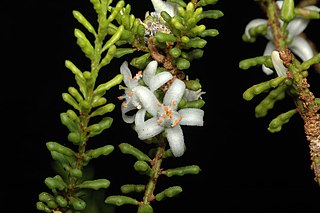
Hibbertia, commonly known as guinea flowers, is a genus of flowering plants in the family Dilleniaceae. They are usually shrubs with simple leaves and usually yellow flowers with five sepals and five petals. There are about 400 species, most of which occur in Australia but a few species occur in New Guinea, New Caledonia, Fiji and Madagascar.

Persoonia brevirhachis is a species of flowering plant in the family Proteaceae and is endemic to the south-west of Western Australia. It is an erect, often spreading shrub with smooth, compact bark, mostly narrow spatula-shaped to lance-shaped leaves with the narrower end towards the base and yellow to greenish yellow flowers borne singly or in pairs in leaf axils.

Darwinia hortiorum is a plant in the myrtle family Myrtaceae and is endemic to Western Australia. It is a compact, densely branched shrub with small leaves and inflorescences composed of up to twenty flowers with glossy, pale yellow to reddish petals and fleshy dark green sepals surrounded by papery brown bracteoles.
Hibbertia acrotrichion is a species of flowering plant in the family Dilleniaceae and is endemic to a restricted area of Western Australia. It is a small, erect shrub with linear, cylindrical leaves and yellow flowers arranged singly in leaf axils with eleven stamens arranged in groups.
Hibbertia ancistrophylla is a species of flowering plant in the family Dilleniaceae and is endemic to the south-west of Western Australia. It is a shrub with sessile, linear leaves and bright yellow flowers arranged singly in leaf axils with eight to eleven stamens fused at their bases on one side of the carpels.
Hibbertia ancistrotricha is a species of flowering plant in the family Dilleniaceae and is endemic to the south-west of Western Australia. It is a shrub with narrow oblong to linear leaves and bright yellow flowers arranged singly in leaf axils with about ten stamens fused at their bases on one side of the carpels.

Boronia octandra is a plant in the citrus family, Rutaceae and is endemic to the south-west of Western Australia. It is a small shrub with three-part leaves and greenish cream to reddish brown, four-petalled flowers.
Eucalyptus purpurata, commonly known as the Bandalup silver mallet, is a species of mallet that is endemic to a small area in the southwest of Western Australia. It has smooth, silvery bark, glossy dark green, lance-shaped adult leaves, flower buds in groups of between seven and eleven, creamy white flowers and shortened spherical fruit.
Philotheca falcata, commonly known as the sickle-leaved waxflower, is a species of flowering plant in the family Rutaceae and is endemic to a small area in the south-west of Western Australia. It is a small, densely-branched shrub with narrow club-shaped leaves and single flowers on the ends of branchlets.
Philotheca fitzgeraldii is a species of flowering plant in the family Rutaceae and is endemic to the south of Western Australia. It is an erect, compact or spreading shrub with cylindrical, glandular-warty leaves and white flowers arranged singly in leaf axils and on the ends of branchlets.
Philotheca nutans is a species of flowering plant in the family Rutaceae and is endemic to the south-west of Western Australia. It is a small, densely-branched shrub with club-shaped to cylindrical, glandular-warty leaves and pendent, pale yellow to pale red flowers arranged singly in leaf axils.

Philotheca pachyphylla is a species of flowering plant in the family Rutaceae and is endemic to Western Australia. It is a small shrub with fleshy, oblong, prominently glandular-warty leaves and white flowers arranged singly in leaf axils.
Philotheca wonganensis, commonly known as Wongan philotheca, is a species of flowering plant in the family Rutaceae and is endemic to the south-west of Western Australia. It is a shrub with thin, cylindrical leaves and white flowers with a pink central stripe, usually arranged singly in leaf axils.

Prostanthera ferricola is a species of flowering plant in the family Lamiaceae and is endemic to central Western Australia. It is an erect, openly branched shrub with aromatic, egg-shaped leaves and mauve-purple flowers arranged in four to twelve leaf axils near the end of branchlets.
Teucrium disjunctum is a species of flowering plant in the family Lamiaceae and is endemic to inland Australia. It is an erect, openly-branched, hairy, greyish-white shrub, usually with egg-shaped to elliptic leaves, and white flowers arranged singly in leaf axils.
Hibbertia acaulothrix is a species of flowering plant in the family Dilleniaceae and is endemic to New South Wales. It is an erect shrub with lance-shaped leaves and yellow flowers arranged singly, with nine to thirteen stamens arranged around the carpels.

Hibbertia acicularis, commonly known as prickly guinea-flower, is a species of flowering plant in the family Dilleniaceae and is endemic to eastern Australia. It is an erect or prostrate shrub with linear to lance-shaped leaves and yellow flowers arranged singly in leaf axils with the six to eight stamens joined at the base, in a single cluster.

Hibbertia acuminata is a species of flowering plant in the family Dilleniaceae and is endemic to eastern Australia. It is an erect shrub with lance-shaped to egg-shaped, stem-clasping leaves and yellow flowers arranged singly in leaf axils with about forty stamens surrounding the carpels.
Hibbertia alopecota is a species of flowering plant in the family Dilleniaceae and is endemic to the Northern Territory. It is a low shrub with elliptic to lance-shaped leaves and yellow flowers arranged singly in leaf axils, with sixteen to twenty-four stamens arranged in bundles around two carpels.
Hibbertia angulata is a species of flowering plant in the family Dilleniaceae and is endemic to a restricted area in the Northern Territory. It is an erect sub-shrub with sessile, linear leaves and yellow flowers arranged singly in leaf axils, with seventeen to nineteen stamens arranged in bundles around the three carpels.








